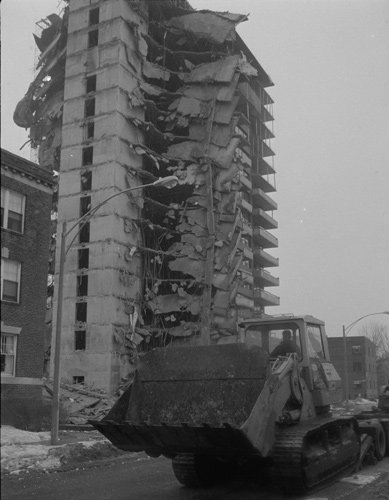Then and now: 2000 Commonwealth Ave. in Brighton

Photo by Stanley Forman, from the BPL Brearley Collection.
On Jan. 25, 1971, a nearly finished 16-story apartment building at 2000 Commonwealth Ave., near Boston College, collapsed, killing four construction workers and injuring a couple dozen more in a slow domino-like pancaking that started with a roof collapse.
The site today is a Boston College dorm, with room for up to 500 students:
The collapse became an infamous case study in how not to build towers, one that architecture and construction students study around the world.
A city commission determined a series of design and construction errors led to the roof collapsing and falling onto the top floor, causing it to fall onto the next floor until nearly two-thirds of the structure had fallen.
Luckily for most of the workers, they were on a coffee break when the collapse started around 3 p.m.
The roof slab began to sag in the shape of a belly and reinforcing steel started sticking out from the mechanical room floor slab. Soon everything started to shake and the east half of the roof slab collapsed onto the sixteenth floor. Then it stopped, giving the workers a chance to run down the stairs to the ground. At the time of failure, the Structural Subcontractor was placing reinforcing steel for the stairs on the fourteenth and fifteenth floors on the east side of the building. So when the workers were making their way from the roof and floors above, most of them crossed over to the west side of the building when they reached the fifteenth floor.
The city condemned what was left of the building and took over the site, which sat vacant for years.
Developer Jerome Rappaport, who built the "If you lived here" towers that replaced much of the West End, bought the lot from the city for $66,000 in 1977. Two years later, Gov. Ed King vetoed a line item in the state capital budget - sponsored by then Brighton state Rep. William Galvin - to have the MDC buy the land to add to its Chestnut Hill Reservoir holdings - according to Globe coverage at the time.
Rappaport eventually began building his own 16-story, 190-unit luxury-apartment tower on the site. In 1985, Brighton City Councilor Brian McLaughlin and Mayor Flynn tried to stop the work, citing outrage from neighbors and a city ordinance barring buildings taller than 70 feet on that stretch of Comm. Ave.
After Flynn revoked the project's building permit, though, district city councilors Tom Menino of Hyde Park and Jimmy Kelly of South Boston introduced a measure to let construction resume - without even consulting McLaughlin.
The Globe reports the council voted 10-3 to let Rappaport continue and the building opened without any collapses.
Rappaport sold the building to a real-estate investment trust, which in turn sold it to Boston College in 2008. Although at first the school continued to rent the apartments to anybody with enough income, in 2015, it received BRA approval to convert the apartments into dorm rooms.
In addition to indoor modifications to turn luxury apartments into student apartment suites, BC also permanently locked the doors to all of the building's balconies.
Top photo posted under this Creative Commons license.
Ad:

Comments
Also as seen on Engineering Catastrophes
Emily Sweeney reported on this story in an episode of Engineering Catastrophes on the Science Channel, Season 5, Episode 9 "Italian Railway Debacle". ( The title refers to one of a few incidents reported in this episode.)
It's streaming in various places, or you can wait for it to repeat on the Science Channel.
Inside job!
There were detonations at critical points. The government was behind this! /s
The neighbors sued
The abutting Reservoir Apartments condominium association sued, one of their points being lack of notice on the zoning hearings to individual owners as opposed to only the condo trust. Ultimately the courts ruled that notice to the association was sufficient, which was the first time that question had been addressed. Not sure how far they pushed it in terms of contesting the actual variance, but at least one of their attorneys was a resident of the complex.
It's a pity Galvin's bill was not approved. It would have allowed more access to the park and reservoir.
Weren't a couple of the
Weren't a couple of the casualties among the workers because some ran back inside to get their tools or something like that?
Why did BC lock the balconies?
Because college kids are
Because college kids are idiots and litigation is expensive.